
The COVID-19 pandemic, and subsequent policy and security measures taken as a result, have impacted the administration of justice in almost every legal system. One of the greatest impacts is that lockdown measures and social distancing have rendered in-person hearings challenging or impossible. The disruption to conducting hearings and other judicial proceedings has the potential to significantly undermine access to justice, due process, and civil and human rights.
Building on initial guidance disseminated in April in the context of the COVID-19 pandemic, the Justice and Corrections Service, within the Office of Rule of Law and Security Institutions (OROLSI), in partnership with the Division for Peace of the United Nations Institute for Training and Research (UNITAR), have developed a Remote Hearing Toolkit.
The Toolkit helps stakeholders determine whether and how to use audio, videoconferencing, and other technologies to conduct remote hearings when in-person hearings are not feasible. Recognizing the distinct challenges faced in different settings and legal systems, this new, highly innovative and interactive tool is not intended to be prescriptive but provides national stakeholders - ministry officials, judges, lawyers, court officials, and others - with a step-by-step decision-making framework for the introduction and use of remote hearing technology.
It is based on a review of existing best practices and common challenges encountered by countries in which peacekeeping and special political missions are deployed, focusing on what is possible in low resource, limited capacity contexts. It reiterates the main international standards to be considered to ensure due process rights, the right to a fair trial and access to justice. The Toolkit should be considered not only as an immediate response to COVID-19 but also, thereafter, to help improve access to justice in contexts where insecurity, limited transport, logistical and other obstacles continue to severely hamper the delivery of justice services.


 DOWNLOAD PDF
DOWNLOAD PDF